
Ignition coils provide the high voltage needed by the ignition system to fire the spark plugs. Most engines that have a distributor ignition system have a single coil, but a few import applications have two coils. On distributorless ignition systems (DIS), multiple ignition coils are used. On "waste spark" systems, each pair of cylinders shares a coil. On other DIS and coil-on-plug (COP) ignition systems, each cylinder or spark plug has its own individual coil.
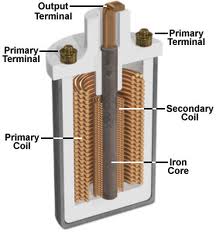
Fig 1. Ignition coil cutaway
The ignition coil serves as a high voltage transformer. It steps up the ignition system's primary voltage from 12 volts up to thousands of volts.
The actual firing voltage needed to create a spark across a spark plug's electrode gap depends on the width of the gap, the electrical resistance in the spark plug and plug wires, the air/fuel mixture, the load on the engine and the temperature of the spark plug. The voltage required is constantly changing and can vary from as little as 5,000 volts up to 25,000 volts or more. Some systems can put out as much as 40,000 volts under peak demand.
HOW AN IGNITION COIL WORKS
Inside every ignition coil are two sets of windings around a laminated or segmented iron core. The "primary" windings, which number a few hundred, are connected to the two external low voltage terminals on the coil. The positive (+) primary terminal connects to the ignition switch and battery while the negative (-) primary terminal connects to the ignition module which provides ground. The "secondary" windings, which have thousands of turns, are connected at one end to the primary positive terminal and the high voltage secondary output terminal in the center of the coil at the other end.
The ratio of secondary to primary windings is typically around 80 to one. The higher the ratio, the higher the potential output voltage of the coil. Performance ignition coils typically have a higher ratio than standard coils.
When the ignition module closes the coil primary circuit and provides a ground, current flows through the primary windings. This creates a strong magnetic field around the iron core and charges up the coil. It takes about 10 to 15 milliseconds for the magnetic field to reach maximum strength.
The ignition module then opens the coil's ground connection and turns the primary coil windings off. This causes the magnetic field to suddenly collapse. The energy stored in the magnetic field has to go somewhere so it induces a current in the coil's secondary windings. Depending on the ratio of turns of wire, this multiplies the voltage up to 100 times or more until there is enough voltage to fire the spark plug.
IGNITION COIL FAILURES
Ignition coils are very rugged and reliable, but can fail for a variety of reasons. Heat and vibration can damage the coil's windings and insulation causing shorts or opens in the primary or secondary windings. But the number one killer of ignition coils is voltage overload caused by bad spark plugs or plug wires.
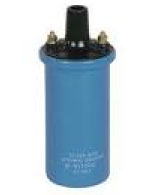
Fig 2. Ignition coil
If a spark plug or plug wire is open or has excessive resistance, the ignition coil's output voltage can rise to the point where it burns through the coil's internal insulation causing a short. The insulation in many coils can be damaged if output exceeds 35,000 volts. Once this happens, the coil's output voltage may drop causing ignition misfire when the engine is under load, or the coil may cease to put out any voltage preventing the engine from starting or running.
If a coil has battery voltage at its positive terminal and is being grounded on and off by the ignition module or circuit but is not producing a spark, the coil is defective and needs to be replaced.
TIP: If the ignition module has failed more than once, it may be due to a bad ignition coil. Internal arcing or shorts in a coil can overload and damage the circuitry inside the ignition module.
IGNITION COIL DIAGNOSIS
When a coil failure occurs on a distributor ignition system, it affects all the cylinders. The engine may not start or it may misfire badly when under load. The misfire may also jump from cylinder to cylinder. But on an engine with a distributorless ignition system (DIS) or coil-on-plug (COP) ignition system, a single coil failure will only affect one cylinder (or two cylinders if it is a DIS waste spark system where two cylinders that are opposite each other in the firing order share the same coil).
If your engine is running rough (misfiring) and the Check Engine Light is on, use a code reader or scan tool to check for misfire codes.
On 1996 and newer engines with OBD II and misfire detection, a coil failure will usually set a P030X misfire code where "X" is the number of the cylinder that is misfiring. A misfire code P0301, for example, would tell you cylinder #1 is misfiring. But a misfire code can be caused by an ignition problem, a fuel problem or a compression problem, so don't jump to conclusions as assume a misfire means a bad coil, spark plug or plug wire. It could also be a bad injector or a compression leak (bent or burned valve).
If the coil is shorted or open, a code may also be set for the coil on that cylinder. If there is no code, you should measure the coil's primary and secondary resistance with a digital ohmmeter. You should also remove and inspect the spark plug. Check the spark gap and look at the deposits on the plug to see if the misfire is due to carbon or oil buildup. Also check the plug wire (if there is one) to make sure the wire's resistance is within specifications.
If the coil, spark plug and plug wire all appear to be okay, the misfire may be due to a dirty or dead fuel injector (check the injector's resistance and voltage supply, and use a NOID light to check for a pulse from the PCM driver circuit. If the injector appears to be okay, do a compression check to see if the cylinder has a bad valve or leaky head gasket.
NOTE: If an engine with a COP ignition system cranks normally but won't start because there is no spark, the problem is not one or more bad coils. More likely, the fault is a bad crankshaft or camshaft position sensor, a voltage supply problem to the coils in the ignition circuit, a bad ignition module (if used), or a bad ignition coil driver circuit in the PCM.
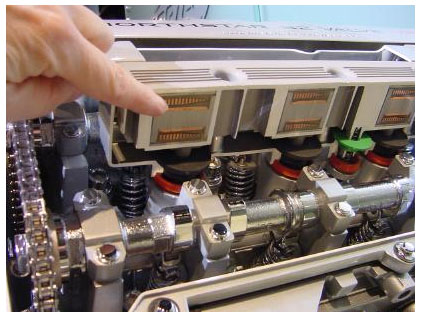
Fig 3. Cutaway of coil-on-plug ignition on a Cadillac Northstar engine
TESTING AN IGNITION COIL
WARNING: Never pull off a plug wire or the coil's high voltage output wire to test for a spark. Besides risking a severe shock, an open plug wire or coil wire will increase the voltage demands on the coil to the point where it may damage the coil. The only safe way to test for spark is to use a spark plug tester tool.
If a coil problem is suspected, measure the coil's primary and secondary resistance with an ohmmeter. If either is out of specifications, the coil needs to be replaced.
A coil can be easily bench tested with a digital 10 megaohm impedance ohmmeter. Refer to the vehicle manufacturers service information for the coil test specifications because the values can vary depending on the application.
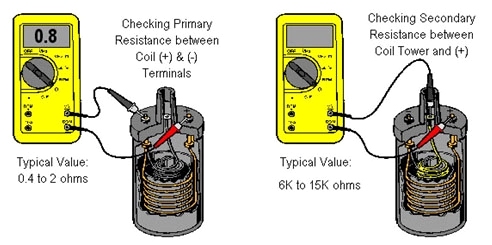
Fig 4. Testing an ignition coil
To test the coil connect the ohmmeter's two test leads to the coils primary terminals (+ and -). Most coils should read between 0.4 and 2 ohms. Zero resistance would indicate a shorted coil while a high resistance reading would indicate an open coil.
Secondary resistance is measured between the positive (+) terminal and high voltage output terminal. Newer coils with segmented core construction typically read 6,000 to 8,000 ohms, while others can may read as high as 15,000 ohms.
On coils that are not a can style, the primary terminals may be located in a connector or even under the coil. Refer to the vehicle manufacturer's service information for the terminal locations and test procedures.
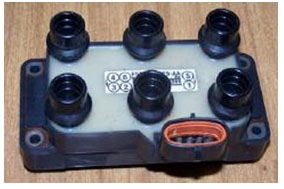
Fig 5. Ford DIS V6 ignition coil.
Note terminals are in coil wiring connector.
A BAD COIL CAN DAMAGE THE PCM
A short that lowers normal resistance in the primary windings will allow excessive current to flow through the coil, which may damage the PCM driver circuit. This may also reduce the coil's voltage output resulting in a weak spark, hard starting, hesitation or misfire under load or when accelerating.
Abnormally high resistance or an open circuit in a coil's primary windings will not usually damage the PCM driver circuit, but it will reduce the coil's secondary voltage output or kill it altogether.
A short that reduces resistance in a coil's secondary windings will also result in a weak spark, but will not damage the PCM driver circuit.
An open or higher than normal resistance in a coil's secondary windings will also cause a weak spark or no spark, and may also damage the PCM driver circuit due to feedback induction through the primary circuit.
REPLACING AN IGNITION COIL
A replacement coil should be the same as the original (unless you are upgrading the ignition system with a higher output performance coil).
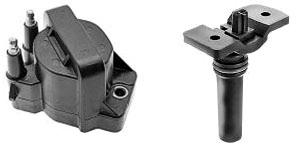
Fig 6. Replacing an ignition coil
When replacing the coil, the connectors should be cleaned and checked for corrosion or looseness to assure a good electrical connection. Corrosion can cause resistance, intermittent operation, or loss of continuity, which may contribute to component failure. Applying dielectric grease to coil connectors that fit over the spark plugs is also recommended to minimize the risk of spark flashover caused by moisture. On Ford truck engines with COP ignition coils, moisture contamination that causes corrosion is the number one cause of coil failure.
If an engine is experiencing repeated coil failures, the coils may be working too hard. The underlying cause may be high secondary resistance (worn spark plugs or excessive spark plug gap), or in rare cases a lean fuel condition (dirty injectors, vacuum leak or leaky EGR valve).
On high mileage engines with COP ignitions, new plugs should also be installed if a coil has failed if the original plugs are conventional plugs with more than 45,000 miles on them, or long-life platinum or iridium plugs with more than 100,000 miles on them.
For more information on vehicle electrical systems, please check out the lots more information in RIBO Parts Articles. 
